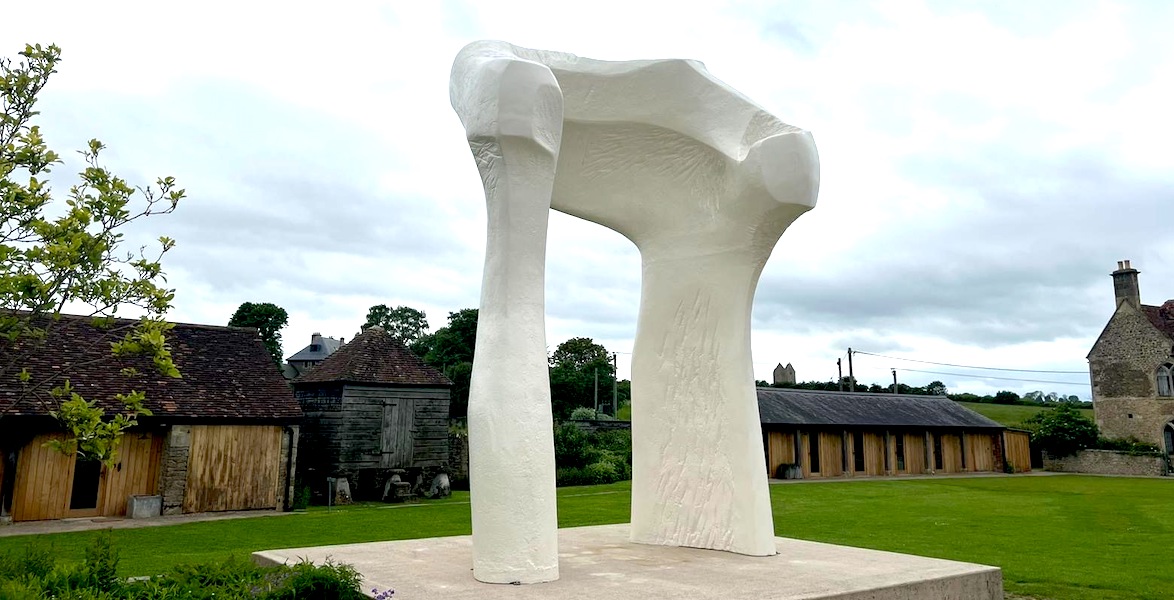In the autumn of 1921, Henry Moore, a student from the Royal College of Art, visited Stonehenge. He checked into his hotel, ready to set off in the morning and see the neolithic monument for the first time. But restless and eaten up with curiosity, he couldn’t wait until the morning. So, in the middle of the night, he made his way over to the site, bathed in bright lunar light. It would have a profound effect on him.
With Moore, negative space is vital to understanding his work
The intensity of the stones set against the moonlit sky would start a career-long investigation into light and depth, space and bulk, and material and volume. His interest in the abstract form and its place in nature would remain with him for his entire career, and Moore would bridge the ancient world and the modern.
A (relative) stone’s throw from the neolithic site, Hauser & Wirth Somerset are staging a major exhibition of works by Moore, curated by Hannah Higham of the Henry Moore Foundation in collaboration with the artist’s daughter Mary Moore. The exhibition takes as its starting point the artist’s early fascination with Stonehenge. Six decades of work are shown in five gallery spaces.
The first work we see is ‘The Arch’ outside the galleries, one of several outdoor pieces that remind us that, like those ancient carvers of Stonehenge, Moore always carved outside.
From 1963/9, ‘The Arch’ is an immense (over 6 metres high) bone-like hybrid of human form and landscape, inspired by a fragment of bone, encapsulating Moore’s ideas on the body as architecture.
Later, in the show, we can see a tiny maquette of the first cast of ‘The Arch’ and see how it evolved from the initial idea (he likened maquettes to an architect’s sketch on an envelope).
It is a sculpture I know well from Kensington Gardens in London, but whereas that version is made of Travertine marble and weighs 37 tonnes, this is fibreglass and weighs considerably less at 1,500 kg!
It was made in 1972 for a major show in Florence, as the stone version would have been too heavy for its setting. A relatively new sculptural material, Moore would end up producing fibreglass versions of many of his most iconic pieces.
With Moore, negative space is vital to understanding his work, and we are encouraged to walk through the arch or the hole that Moore saw as having “as much shape-changing meaning as a solid mass.”

The fascination with nature continues inside the Threshing Barn gallery with a series of four towering bronze sculptures (he made 9) created between 1955 and 1979 and inspired by Poplar trees which suggested sculptural forms to Moore.
It is the grouping of these works (made decades apart) that is fascinating. Now we see the relationship between the forms and the spaces between them, and we are reminded of prehistoric monoliths. It is crucial, as with all of Moore’s work, that you approach them from all angles. He famously championed the principles of direct carving and truth to materials, and with these works, we can really see how he worked with stone and allowed its natural properties to emerge. I loved the deep cuts and grooves you see on close inspection. You can almost hear Moore chipping away at the stone.
The Workshop Gallery features Moore’s Stonehenge series. Etchings and lithographs made half a century after that first moonlight visit.
In the Pigsty gallery is a fascinating cabinet of artefacts, which for me, pulled the show together.
It is a deeply personal selection of artworks and objects curated by his daughter Mary Moore. The collection (which he moved with him as he moved house) contains almost 100 items from Henry Moore’s studio and home. As well as the maquette for “The Arch”, there are several others (small enough to fit in your hand) and a collection of his personal ethnographic pieces, including Mayan, Aztec, Oceanic and Classical. We also find some of the tools he used daily and his collection of found natural objects (he often got ideas from pebbles, shells and, of course, bones). It is a wonderful insight into Moore’s unique visual library and the vocabulary of ideas that he developed during his working life.

In the same room is a totemic sculpture which turns out to be a bird bath he made for his garden! We are told by Mary Moore that her father would hang coconuts off it and place a plate on top for bird seed. Despite the holes he made throughout, birds would never enter the holes. Too much respect for negative space, I suspect!
The final room, the Bourgeois Gallery explores one of Moore’s favourite subjects: Internal/external forms. It was a natural progression from the holes in his work, another way of looking at sculptural ideas by presenting one form in another, and one he would employ to brilliant effect in his most well-known theme – the mother and child.
In this gallery, we see how he absorbed and synthesised disparate ideas. Helmets in the Wallace collection, mathematical models in the Science Museum, shells and crustaceans in the Natural History Museum, seed pods and human skulls all became stimuli for Moore’s creativity in an explosion of inventive brilliance.
This is an unmissable show, brilliantly curated, that stayed with me long after. In fact, going back to London on the train, it was hard to look at the passing scenery without seeing it as one endless series of sculptures.
Henry Moore: Sharing Form, Hauser & Wirth Somerset, 28 May – 4 September 2022
Words and Photos James Payne ©James Payne and Artlyst 2022
Lead image: Henry Moore, The Arch 1963-9 ©James Payne

